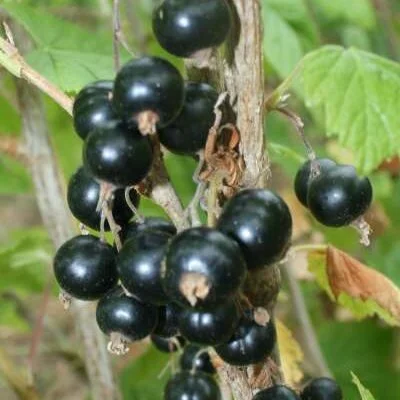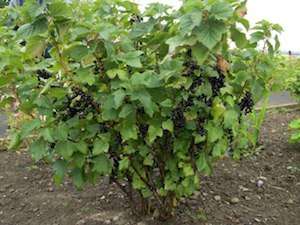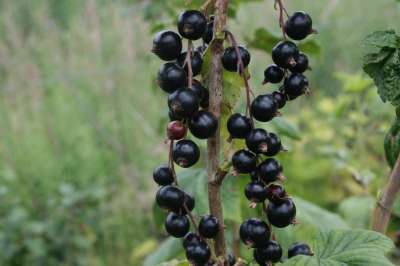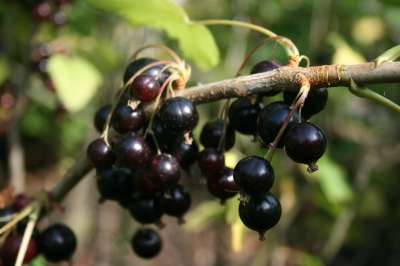Your basket is currently empty!
In a nutshell……..
- Space 5′ apart [1.5 metres]
- Yield – established bushes give 10lbs or more
- Siting – full sun to partial shade
- Soil – any reasonable soil with adequate drainage
- Plant – Oct-April approx as bare root, pot-grown at other times
- Pruning – remove a proportion of older stems, cutting out at the base in Winter
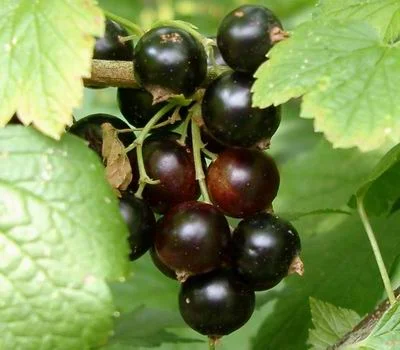
Index
- Spacing
- Scottish Blackcurrant Varieties
- Preparing the soil for your new bushes
- Planting
- Planting pot grown bushes
- When to plant blackcurrants
- Pruning Blackcurrant bushes
- Blackcurrants cordons
- Feeding and aftercare
- Frost protection
- Bird protection
- Choice of variety
- Growing Blackcurrants as standards
- Growing in blackcurrants in pots
- Growing Blackcurrants for extra large fruits
- Pests and Diseases
- The Jostaberry
View our range of Blackcurrant Bushes
A well established blackcurrant bush can yield 10 ibs or more fruit and will remain productive for up to 15 years. That’s a very generous supply of blackcurrants you can make countless jars of jam from, and the fruits are also ideal for freezing, juicing, adding to yogurts etc. Blackcurrants grow not as a tree but as a bush with multi stems arising from the base. They will usually grow to around 5′ and the same across [about 1.5 metres] They are hardy, deciduous and strongly, pleasantly, resinous.
Blackcurrants are probably the easiest of all the soft fruits to please. Any soil is suitable, they can tolerate heavier and more poorly drained sites than other fruit bushes, and even a little shade. Which is not to say that more ideal situations won’t reap greater rewards, because they will. Generous hearty soil, plenty of sun and a good feeding regime makes all the difference. But a blackcurrant bush will also shrug off less promising conditions and still yield fairly well.
Disease became a problem some years ago and in many older stocks significant disease became ingrained. So make sure you buy healthy stocks from reputable growers to get the best start.
Spacing for blackcurrant bushes
An average blackcurrant bush will require a spacing of 5’ and it will grow the same in height. Some varieties are slightly more or less vigorous than this and of course it is also dependant on soil, but 5’ is a good average.If you are short of space look for the newer compact variety ‘Ben Sarek’ which can be spaced just 3.5’ apart and is also shorter in growth.
Scottish Blackcurrant Varieties
These days the Blackcurrant scene is dominated by ‘Ben’ prefix varieties and these have revolutionised blackcurrant production in this country. They are defined by extra frost hardiness as well as bountiful crops, and they all hail from the SCRI. When choosing varieties I wouldn’t look any further than these for all round top class results and reliability. Our nursery also maintains a collection of older historic varieties as well and they’re nice to keep and some of our more ardent customers like to grow a few for old-times sake, or because they like something different to the norm. They have their qualities but I would not recommend them for general culture, especially where only a few bushes can be cultivated. Similarly there is a plethora of European introductions and most of those seem to suffer more from disease and or frost damage.
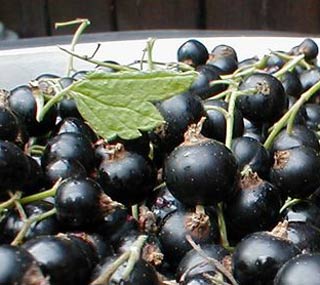
Preparing the soil for your new bushes
It is better where possible to prepare the area some weeks in advance of planting to allow the soil to settle and so that all weeds can be removed which is a task that can’t really be done thoroughly in one go.
The area allocated for the bushes should be double dug until it attains a fine tilth. Growmore at a rate of 3oz’a per square yard should be applied and a thick covering of compost or well rotted manure to 3 or 4” depth. Your ground is now ideal for the planting of new blackcurrant bushes.
Planting Blackcurrants
Identify the positions for the holes with split pea sticks, spacing 5’apart each way. A hole should be dug wide enough to accept the roots without cramping or bending them. Blackcurrants do better if they are planted quite deeply, perhaps a shade deeper than they were at the nursery You can usually identify the soil mark around the base of the bush that will tell you how deeply it was planted before.
When you are satisfied the bush is at the correct depth, infill with nicely friable soil mixed with a little compost and firm down very well with the heel of your boot. The soil should now be level with that of the surrounding ground.
Bare rooted bushes will be planted during the dormant season so only a light watering to settle them in is required, thereafter no watering is usually required and they should have new root growth in place to support strong growth by the Spring. For this reason earlier planting is better than late planting, because you will find during any mild winter weather the bushes will already start to make new root growth in readiness. Plant a blackcurrant bush in October and lift it again in January [not recommended, but hypothetical] and you will likely find a forest of short white new roots already present.
Planting pot grown bushes
The principals are the same except that you will be making a hole approximately the same size as the rootball. If the rootball is congested tease out some of the roots so they can make there way into the new soil and facilitate establishment. Container grown bushes will normally be planted during the growing season, from April to September so heavy regular watering is necessary until they are established. Aim to water twice a day for the first 2 or 3 weeks, in the early morning and again in the evening when it is cooller and the water will do more good and be more readily taken up by the roots. Thereafter once every other day is normally sufficient until the bushes are established. Blackcurrants establish more easily than almost any other fruiting plant.
When to plant blackcurrants
These days it is possible to plant all year round. Planting of bare rooted bushes during the dormant season, from October to April is to be preferred because the bushes establish will little intervention or aftercare and receive little shock at this time. They are impervious to the elements and thoroughly hardy once they are in the ground. If you need to plant at another time, during the Spring and Summer, then this is also perfectly possible but at this time you will be planting pot grown bushes. Regular watering as described above is necessary to get them going but thereafter establishment is usually quick and satisfactory and the bushes will be well placed to make more significant growth the next year and they will be well established before winter.
Pruning Blackcurrant bushes
After planting you should cut all the shoots back to 2” from the base. Yes, really. Having performed this task you might stand back and wonder “oh my, what have I done?!” But don’t worry, having brutalised your brand new bushes they will come back all the stronger and basal buds will form strong new shoots next season which will be much better placed to yield well the year following that. You can leave your bushes ‘up’ and they will crop sooner because of it [Blackcurrants only fruit on well ripened 2 year wood] but long term they will suffer from a lack of strong new growth in the early stages. When your receive your bushes they will probably already have been ‘tipped’ or cut back a little to facilitate packing, but don’t make the mistake of assuming they have already been pruned for you. You must cut them back much lower than that, and as described above. The nursery will usually leave them higher than they need to be when supplying because customers don’t like to receive plants with nothing to show except a few stumps and some root!
In the future you will find that although older stems will continue to produce some fruit the bulk of the crop – and the best quality fruits – is borne on second year growth. So you should aim to remove a number of older stems each year pruning them back to the base in the winter. This wil encourage and make room for strong new shoots to come through the next Spring, and these will then crop the summer of the next year. Aim to remove up to a third of the old stems annually. It might seem confusing at first, which is the old and which is the new? With a practiced eye, it becomes clearer as the new shoots are usually paler and shinier, old stems are often a bit green with algae and moss, more rugged and thick in appearance, and you can often see the dead stalks of the previous seasons crop still adhering to the stem.
Blackcurrants cordons
The blackcurrant is seldom grown as a cordon because the pruning and growing method is different to other currants and gooseberries. As can be imagined, a bush that needs it’s old stems removing regularly to keep it invigorated and encourage a fresh supply of fruiting wood, isn’t really going to be much use as a cordon. But if you really are tucked for space and you want to allocate just 18” for a cordon then it is still possible to grow a blackcurrant in this way, allowing the main stems to fruit for 2/3 years and then removing one of two main stems and allowing another to replace it. Not the most satisfactory of growing method but doable if you have no other choice.
Subsequent feeding and aftercare
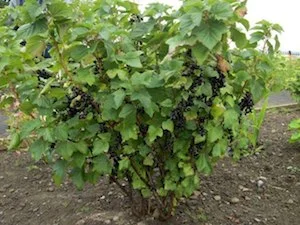
Blackcurrants are vigorous growers and prolific fruiters so a hearty feeding regime will give them the strength and impetus to gift you the best results possible.
Growmore or bonemeal can applied once again at 3oz’s per sq yard, in February or early March of each season. At the same time re-apply mulch as Blackcurrants like to remain nice and moist during the summer. You can consider extra watering from June to September when the bushes are most active, water with a hose as mature bushes will have an extensive root system so really puddle that water around the base of the bushes for the most effect and extra luscious large berries.
Weed control is important because they compete with the bushes for nutrients and water. So be vigilant and remove any weeds as they appear. Because blackcurrants are fairly shallow rooted [another reason why extra watering is an advantage] it is best to lightly hoe or hand weed, or herbicides can be applied with care as the bushes are usually devoid of much foliage at the base.
Frost protection
Blackcurrants are pretty hardy and if growing the newer varieties frost isn’t usually a consideration and is never a problem to resting dormant bushes. But the flowers open in May and it is possible for them to be caught by late frost and, particularly in the case of older varieties, crops can significantly be reduced or wiped out completely if this happens. So if frost is forecast and your bushes are bedecked with flowers, make the effort and cover them with horticultural fleece for the night. It is important that this is removed during the day as the flowers are pollinated by day flying insects and bees so if they can’t gain access to the flowers, you won’t get a harvest!
Bird protection
Blackcurrants aren’t the favoured snack for our avian friends. Maybe it’s the colour, or the strong aroma, but they would much rather go for gleaming redcurrants, strawberries or raspberries if available. But that’s not to say they won’t tackle blackcurrants, they will if there isn’t a more attractive option. So be on guard with a shotgun [or perhaps not].
On second thoughts, protect the bushes as the berries begin to ripen with netting, or various other bird scaring devices can be found on the garden centre shelves.
Blackcurrant pollination.
There are no issues with pollination, all varieties are self compatible so even lone bushes will fruit to maximum capacity. The flowers are pollinated by bees and other insects. So for this reason better pollination and fruit set will be achieved if the bushes are sited in a more sheltered position with some sun, conditions where insects are more active.
Choice of blackcurrant variety
Your newer varieties are much the best as they will be able to shrug off disease and late frosts more easily meaning they will still perform even without intervention from you. Another consideration to make when choosing which varieties to grow [the choice can be bewildering with some fruit specialists listing 20 or more varieties] is that of season. Varieties have been bred to extend the normal harvest period, so if you can grow a range of varieties this will make sure you are picking fresh blackcurrants for the longest possible period. If you tend to use your blackcurrants for freezing or jam making then you may prefer to have one concentrated pick and get the job done all at once in which case choose a good maincrop variety you know will fare well.
Blackcurrants tend to ripen in July, some of the latest varieties will fruit into August and a few very early varieties may be ripe by late June. So it is possible to have a 6 week picking season for Blackcurrants if you are canny with your choice of variety.
Growing Blackcurrants as standards
An increasingly popular way of growing Blackcurrant bushes is on a standard leg, rather like a standard rose. The bush attains roughly the same size as if it were a conventional one but it is supported on a clear stem, usually this is grafted at around 40”. The way in which this is produced on the nursery is a very specialised procedure. The bush is grafted onto a rootstock stem of the closely related Ribes aureum, but the host is not allowed to grow and any resultant shoots are rubbed off until the blackcurrant cutting has ‘taken’ Often two or more grafts are inserted onto the host stem so as to ensure a nice rounded head. It takes at least 2 years to produce a good standard Blackcurrant so the price is much more expensive than a normal bush.
Cultivation as to soil requirements and pruning is just the same, there is no difference. But it is easier to harvest the fruits from a standard currant as the branches are roughly head-high, so no bending or stooping is required. They make quite a formal and attractive feature too and it is possible to plant beneath them so they might be viewed as a more sensible use of space. But they can get quite top heavy so they need a sheltered position and their retail cost doesn’t really allow for planting in quantity. They are suitable also for growing in larger containers of 24” or so. Standard currants really need a good strong cane or a 2 x 2” standard rose stake to support the weight of the head.
Keep an eye out for suckers springing from the main stem, because these will be of the rootstock, not the blackcurrant. Although they should largely have stopped being produced by the time you get your new standard currant growing, it is possible for them to appear again at any time during the life of the ‘tree’.
Growing in blackcurrants in pots
Although not the first choice that comes to mind when thinking of fruit to grow in containers – maybe because they are so accommodating in the ground, or maybe perhaps because they aren’t the most attractive of things. But nevertheless it is possible to grow them in pots. I would recommend a container not less than 18” and either a proprietary all-purpose peat based compost can be used, a custom mix of peat, sharp sand and leaf mould/organic matter, or you can use loam based potting compost. Ben Sarek is by far the best variety for container growing because it is much more compact in growth and requires less pruning. Any other variety is suited to this method of cultivation as well, but the rangier growers will simply look untidy.
Pruning is the same as for bushes grown in the ground and regular hearty feeding is important to ensure a reliable supply of young growth to continue the fruiting cycle. For this purpose I would use a combination of miracle-grow, Osmocote tabs [slow release tablets you insert just one a year] and the occasional foliar feed of maxicrop. Beware the same bugs and diseases as for bushes grown in the open ground.
Blackcurrants in containers ought to produce well for four to five years in a good big pot. At this point I would probably recommend re-potting and this should take place in the Winter time. Shake off some of the compost from the roots – you can be quite robust in this – cut all of the growth back to near the base and allow the bush to start again and rejuvenate, repotting it in the same container with fresh compost. You should then be able to cultivate the same bush in a container for up to seven or eight years, after that it would be best to discard it [or plant it out] and start again.
Growing Blackcurrants for extra large fruits
Maybe you have a penchant for big-is-beautiful berries and fruits, perhaps the sheer size of out of the ordinary fruits thrills you, or maybe you are an erstwhile exhibitor? Either way few of can resist the temptation of extra large fruits. With blackcurrants it is perhaps fairly easy to gain exhibition-quality specimens. Cultivation plays a part but so to does variety selection. It pays to choose a variety that has large berry size as one of it’s attributes in the first place, and this can then be accentuated still further by generous cultivation techniques. There are three varieties to consider – Ben Conan, Big Ben and Goliath, or maybe Laxtons Giant too. The first two are really the most satisfactory with big fruits individually nearly twice the size of normal blackcurrants, and easily produced too. They are also frost hardy and reliable.
The way to encourage these fruits to get even bigger is to feed very generously of course, but also to thin the individual trusses and also to limit the overall truss quantity the bush is producing, by perhaps reducing the total number of strigs by up to a quarter. Individually the trusses should not be allowed to keep more than three or four berries each and in this way you maximise still further the stunning size of the individual berries.
The other important aspect of cultivating for show-standard berries is that of water. Copious amounts at key times, which in this instance would be from soon after fruit-set. And do be consistent about it – if it’s too irregular and boom-or-bust you risk getting a lot of fruits with split skins.
Pests and diseases
Here is a run down of the problems you are most likely to encounter.
Greenfly and Aphid
Are the most commonly troublesome critters, causing soft new growth to curl and become distorted, sometimes it also become streaked with yellow. These insects overwinter on the bush so the first step to eradication is to provide a winter wash all over the bush whilst it is dormant. Insecticides are still very effective but you need to start early, soon after the first leaves emerge and repeat applications as directed by the manufacturer. If you have left it too late and your blackcurrants already show signs of heavy infestation, be prepared to snip off the ends of the new growth where the damage is worst, destroy these growths, and then spray. Unchecked greenfly populations sap the strength of the bush and they also spread diseases.
Mildew
This is a fairly commonplace problem with blackcurrants and is more troublesome with the older varieties but not exclusively so. The leaves become silvery and powdery and it can spoil the fruits too. Sometimes this fungal disease is encouraged by a lack of pruning as too much congested or soft growth encourages it. It is fairly easily dealt with by a proprietary insecticide [we use systhane but so many are being withdrawn all the time, it’s a matter of what your local stockist can recommend] but again prevention is better than cure so start an early spraying programme to prevent it getting a hold in the first place.
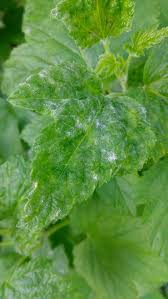
Big Bud
Is a more serious disease as there isn’t really a cure. It is characterised by the buds beginning to swell in the spring but they never develop beyond that point and remain inflated, the reason being they are infested with numerous tiny mites that invaded the buds very early in the season, moving from infected buds to healthy ones.
Treatment is generally advised by picking off infected buds and destroying them, thus limiting the spread of the mites. It is quite easy in the winter to determine the damaged buds from the healthy ones, but it is a very laborious task especially if you have more than one or two bushes. Most sprays that were in part effective have been removed from use, and it is difficult to kill the mites because they spend nearly all of their time concealed inside the tissue of the plant. A systemic insecticide such as Provado can help, but timing is critical as you will need to apply just as the buds begin to swell in the spring but you need also to be fastidious because it is difficult to get a good application at this time when there is so little growth. This treatment will likely need to be applied several times, and over more than one season, before it begins to take effect.Another remedy is to re-plant with the resistant variety ‘Seabrooks Black’
Leaf spot
Begins life as small brown spots on the leaves which gradually become larger and coalesce. Leaves fall prematurely and the resultant crop is usually affected. The disease can be controlled by the use of a broad spectrum fungicide, applied shortly after flowering. Extra feeding is usually effective to help the bushes regain vigour that has been lost. Can also infect red and whitecurrants.
The Jostaberry
An unusual Blackcurrant hybrid raised from a cross between a Blackcurrant and a Gooseberry. It resembles more closely a Blackcurrant but the leaves are smaller and shinier and the fruit are larger and sweeter. The bush has a faint blackcurrant odour but it is not as strong. This increasingly popular hybrid berry should be treated and grown just as you would a Blackcurrant bush. It is quite vigorous in growth so alow 6′ or so for one bush. View our Jostaberry >
View our full range of Blackcurrant Bushes



